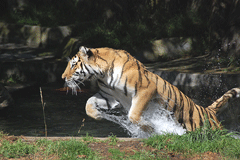Born to Be Wild
Air Date: Week of January 11, 2008

Tatiana at the San Francisco Zoo in October, 2007. (Photo: Flickr/MumbleyJoe)
In the aftermath of the Siberian tiger attacks at the San Francisco Zoo, commentator Sy Montgomery ponders a number of questions, including whether predatory animals are meant to be kept in captivity.
Transcript
CURWOOD: Another cat story shocked the nation on Christmas Day. That was the news that Tatiana, a Siberian tiger, escaped her San Francisco Zoo enclosure, killed one young man and mauled two others before police shot and killed her.
Now there’s debate about what went wrong. Commentator Sy Montgomery asks we consider different issues.
MONTGOMERY: How could this have happened? Was the tiger helped out of its enclosure? Did the men provoke the attack? Did they tease the tiger?
In the aftermath of the San Francisco Zoo tragedy, we’re asking the wrong questions. A tiger attacked three people, and we’re at a loss to understand why. That’s because we completely misunderstand predators.
True, if you taunt a tiger, you should prepare for natural selection to do its work. But tigers don’t attack because they’re angry. Tigers don’t attack because they are mean. Tigers attack because they are tigers.

Tatiana at the San Francisco Zoo in October, 2007.
(Photo: Flickr/MumbleyJoe)
Like all predators, tigers love nothing in this world more than to hunt—to stalk, to chase, to spring. A kitten playing with a ball of string is doing the same thing. For a predator, hunting is the most essential and rewarding of all pleasures.
And Tatiana? She probably didn’t mean to hurt anyone. That people were hurt was incidental. What Tatiana wanted—what all tigers want, what all predators want—was not to kill, not to eat—she was well-fed at the zoo—but to hunt. It’s what predators do.
Falconers—folks who hunt with the predatory birds—know all about this. In the elaborate lexicon of falconry, there is a word that addresses this instinctive hunting desire: yarak. At the New Hampshire School of Falconry, my instructor Nancy Cowan said yarak doesn’t have a precise definition. It might come from the Persian word for power or strength—or from the Turkic for the right heat for tempering metal. But falconers know what it means—and what you do about it.
Yarak is the often explosive build-up of hunting drive. The falconer ignores it at his peril. Otherwise, your bird might fly at your face with her talons. Not that she’s hungry or angry. She’s frustrated, deprived of her chance to chase.
Most American zoos won’t let their tigers chase live prey. The public doesn’t want to see that, or even know about it. But—and here’s the odd thing—the public wants to see tigers. We want to admire these ‘magnificent predators.’ As long as the predators are harmless. As long as they don’t kill anything.
But then, are we really seeing a predator? Can we hope to understand a predator that never chases prey? Do we have the right to keep tigers in captivity? Is there a way to keep a captive tiger psychologically whole? Can we honor their yarak?
These are the questions we should be asking—and we should answer them before another Tatiana pays with her life for the sin of being a tiger.
CURWOOD: Author Sy Montgomery works with wild tigers in India. Her book about her experiences is called “Spell of the Tiger: The Man-Eaters of Sundarbans.”
Links
Living on Earth wants to hear from you!
Living on Earth
62 Calef Highway, Suite 212
Lee, NH 03861
Telephone: 617-287-4121
E-mail: comments@loe.org
Newsletter [Click here]
Donate to Living on Earth!
Living on Earth is an independent media program and relies entirely on contributions from listeners and institutions supporting public service. Please donate now to preserve an independent environmental voice.
NewsletterLiving on Earth offers a weekly delivery of the show's rundown to your mailbox. Sign up for our newsletter today!
 Sailors For The Sea: Be the change you want to sea.
Sailors For The Sea: Be the change you want to sea.
 The Grantham Foundation for the Protection of the Environment: Committed to protecting and improving the health of the global environment.
The Grantham Foundation for the Protection of the Environment: Committed to protecting and improving the health of the global environment.
 Contribute to Living on Earth and receive, as our gift to you, an archival print of one of Mark Seth Lender's extraordinary wildlife photographs. Follow the link to see Mark's current collection of photographs.
Contribute to Living on Earth and receive, as our gift to you, an archival print of one of Mark Seth Lender's extraordinary wildlife photographs. Follow the link to see Mark's current collection of photographs.
 Buy a signed copy of Mark Seth Lender's book Smeagull the Seagull & support Living on Earth
Buy a signed copy of Mark Seth Lender's book Smeagull the Seagull & support Living on Earth

